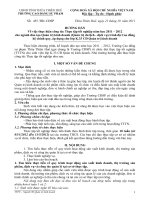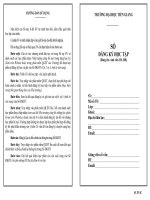ANKYLOGLOSSIA - K.TMH - 22-4-2014
Bạn đang xem bản rút gọn của tài liệu. Xem và tải ngay bản đầy đủ của tài liệu tại đây (2.27 MB, 15 trang )
ANKYLOGLOSSIA
LIEN CHUYEN KHOA
ANKYLOGLOSSIA
1 . INTRODUCE
2 . ANATOMY
3 . DIAGNOSIS
4. EFFECTS
5. TREATMENT
ANKYLOGOSSIA
1. INTRODUCE
Ankyloglossia is a congenital oral anomaly is caused by an unusually short, thick
lingual frenulum
Ankyloglossia varies in degree of severity from mild cases characterized by
mucous membrane bands
2 ANATOMY
2. ANATOMY
3. DIAGNOSIS
Diagnosis of ankyloglossia may be difficult
It is often dependent on the range of movement permitted by the
mucous membrane bands
4. EFFECTS
Feeding
Speech /n/ / t/ /d// l/ /r/ /s/ /z//th/
Oral hygiene
Mandibular prognathism;
5. TREATMENT
Some advocate waiting until the child is at least four years old because of the
chance that the tongue may spontaneously elongate as it is used
No treatment is usually required and only severe cases where symptoms are
particularly problematic which surgery be recommended
5. TREATMENT
5. TREATMENT
THANKS FOR YOURS ATTENTIONS !
4.DIAGNOSIS
Frenulum extending along 25%–100% of tongues’ total length
Hazelbaker’s assessment tool17 for lingual frenulum function
Frenulum thick; tongue heart-shaped when protruded
Hazelbaker’s assessment tool17 for lingual frenulum function
Thank for yours attention!
REFERENCES
Mueller DT, Callanan VP. Congenital malformations of the oral cavity. Otolaryngol Clin North Am 2007; 40:141.
Messner AH, Lalakea ML. Ankyloglossia: controversies in management. Int J Pediatr Otorhinolaryngol 2000; 54:123.
Brinkmann S, Reilly S, Meara JG. Management of tongue-tie in children: a survey of paediatric surgeons in Australia. J Paediatr Child Health 2004; 40:600.
Hall DM, Renfrew MJ. Tongue tie. Arch Dis Child 2005; 90:1211.
National Institute for Health and Clinical Excellence. Division of ankyloglossia (tongue-tie) for breastfeeding. nice.org.uk/guidance/index.jsp?action=byID&o
=11180 (Accessed on June 25, 2008).
Cinar F, Onat N. Prevalence and consequences of a forgotten entity: ankyloglossia. Plast Reconstr Surg 2005; 115:355.
Messner AH, Lalakea ML, Aby J, et al. Ankyloglossia: incidence and associated feeding difficulties. Arch Otolaryngol Head Neck Surg 2000; 126:36.
Segal LM, Stephenson R, Dawes M, Feldman P. Prevalence, diagnosis, and treatment of ankyloglossia: methodologic review. Can Fam Physician 2007; 53:1027.
Hogan M, Westcott C, Griffiths M. Randomized, controlled trial of division of tongue-tie in infants with feeding problems. J Paediatr Child Health 2005; 41:246.
Ricke LA, Baker NJ, Madlon-Kay DJ, DeFor TA. Newborn tongue-tie: prevalence and effect on breast-feeding. J Am Board Fam Pract 2005; 18:1.
Ballard JL, Auer CE, Khoury JC. Ankyloglossia: assessment, incidence, and effect of frenuloplasty on the breastfeeding dyad. Pediatrics 2002; 110:e63.
Garcia-Pola MJ, Garcia-Martin JM, Gonzalez-Garcia M. Prevalence of oral lesions in the 6-year-old pediatric population of Oviedo (Spain). Med Oral 2002; 7:184.
Flinck A, Paludan A, Matsson L, et al. Oral findings in a group of newborn Swedish children. Int J Paediatr Dent 1994; 4:67.
Sedano HO, Carreon Freyre I, Garza de la Garza ML, et al. Clinical orodental abnormalities in Mexican









